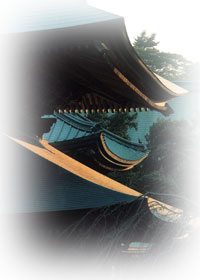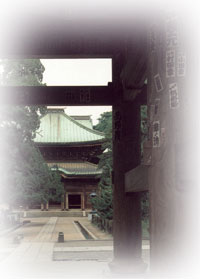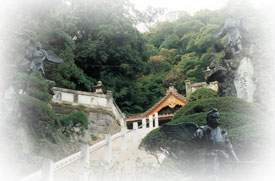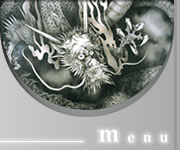
Kencho-ji, the
first monastery in Japan devoted solely to Rinzai Zen practice, is number
one of the Kamakura Five Mountain Zen temples, and the head of the Kencho-ji
branch of Rinzai Zen Buddhism, with four hundred affiliated temples.
Kencho-ji was founded in 1253 by the fifth Kamakura regent Hojo Tokiyori
北条時頼 (1227–1263), with the support of Emperor Gofukakusa 後深草 (r. 1246–1259).
Tokiyori, who wished to establish a true Rinzai monastery in the city of
Kamakura, the capital of the shogunate, invited the eminent Chinese Rinzai
Zen master Lanxi Daolong 蘭溪道隆 (J. Rankei Doryu; 1213–1278) to serve as first
abbot. Lanxi held that position until 1262, when he was appointed the
eleventh abbot of Kennin-ji in Kyoto. Lanxi was succeeded by the Chinese
master Wuan Puning 兀菴普寧 (1197–1276), but later returned as third abbot.
Under Lanxi and subsequent abbots Kencho-ji became a renowned center of Zen
training, with over one thousand monks in training. The monastic code
written by Lanxi to guide the practice of his students is preserved as a
National Treasure.
Kencho-ji originally had the full array of structures designated in
classical Chinese Zen monastic design, with seven main buildings and
forty-nine subtemples. Although subject to a series of early disasters,
notably an earthquake in 1293 and a fire in 1315, Kencho-ji prospered during
the Kamakura period with the support of the Hojo family, and during the
early Muromachi period was named first of the Kamakura Five Mountains by
Ashikaga Yoshimitsu 足利義滿 (1358–1408), the third Ashikaga shogun. A serious
fire in 1414 destroyed much of the temple, however. Kencho-ji revived
somewhat during the Tokugawa period, when the shogunate supported Buddhism,
but went into decline again following the Meiji Restoration in 1868, when
government interest shifted to the development of State Shinto. The
situation eased somewhat with the establishment of the railroad between
Tokyo and Kamakura in 1889, which helped spur a revival of Kencho-ji and all
Buddhist temples in Kamakura.
 The valley in
which Kencho-ji is located, known as Hell Valley, was an execution ground in
ancient times in which stood a temple named Shinpei-ji 心平寺. Because of its
violent history, the area has many images of Jizo 地藏, the bodhisattva whose
mission it is to save those who are lost or in danger, or who have fallen
into the hell realms. The main image in the Buddha Hall of Kencho-ji is Jizo
Bodhisattva (quite unusual for a Zen temple), and within the hall are
several other famous Jizo images, including the Shinpei-ji Jizo and the
Saita 濟田 Jizo, plus hundreds of small cast-iron Jizo. Also in the hall are
five images of garanjin, guardian deities of Taoist origin. The hall itself
was brought here in 1647 from Zojo-ji 増上寺, an important Pure Land Buddhist
temple in Tokyo associated with the Tokugawa family.
The valley in
which Kencho-ji is located, known as Hell Valley, was an execution ground in
ancient times in which stood a temple named Shinpei-ji 心平寺. Because of its
violent history, the area has many images of Jizo 地藏, the bodhisattva whose
mission it is to save those who are lost or in danger, or who have fallen
into the hell realms. The main image in the Buddha Hall of Kencho-ji is Jizo
Bodhisattva (quite unusual for a Zen temple), and within the hall are
several other famous Jizo images, including the Shinpei-ji Jizo and the
Saita 濟田 Jizo, plus hundreds of small cast-iron Jizo. Also in the hall are
five images of garanjin, guardian deities of Taoist origin. The hall itself
was brought here in 1647 from Zojo-ji 増上寺, an important Pure Land Buddhist
temple in Tokyo associated with the Tokugawa family.
Kencho-ji’s temple bell, hung in a thatched belfry not far from the Buddha
Hall, dates back to the founding of the temple, and is inscribed by the
founding priest, Lanqi. It is designated a National Treasure.
 In front of the
Buddha Hall are seven large Chinese juniper trees, called byakushin in
Japanese. They are said to have grown from seeds brought by Lanxi Daolong
from China, and are thus more than 700 years old. Behind the Hojo (also
called the Ryuoden 龍王殿, the Dragon King Palace) is a garden said to have
been designed by the Zen master Muso Soseki, with a pond named the Shinji-ike
心字池, the “Mind-character Pond.”
In front of the
Buddha Hall are seven large Chinese juniper trees, called byakushin in
Japanese. They are said to have grown from seeds brought by Lanxi Daolong
from China, and are thus more than 700 years old. Behind the Hojo (also
called the Ryuoden 龍王殿, the Dragon King Palace) is a garden said to have
been designed by the Zen master Muso Soseki, with a pond named the Shinji-ike
心字池, the “Mind-character Pond.”




 The valley in
which Kencho-ji is located, known as Hell Valley, was an execution ground in
ancient times in which stood a temple named Shinpei-ji 心平寺. Because of its
violent history, the area has many images of Jizo 地藏, the bodhisattva whose
mission it is to save those who are lost or in danger, or who have fallen
into the hell realms. The main image in the Buddha Hall of Kencho-ji is Jizo
Bodhisattva (quite unusual for a Zen temple), and within the hall are
several other famous Jizo images, including the Shinpei-ji Jizo and the
Saita 濟田 Jizo, plus hundreds of small cast-iron Jizo. Also in the hall are
five images of garanjin, guardian deities of Taoist origin. The hall itself
was brought here in 1647 from Zojo-ji 増上寺, an important Pure Land Buddhist
temple in Tokyo associated with the Tokugawa family.
The valley in
which Kencho-ji is located, known as Hell Valley, was an execution ground in
ancient times in which stood a temple named Shinpei-ji 心平寺. Because of its
violent history, the area has many images of Jizo 地藏, the bodhisattva whose
mission it is to save those who are lost or in danger, or who have fallen
into the hell realms. The main image in the Buddha Hall of Kencho-ji is Jizo
Bodhisattva (quite unusual for a Zen temple), and within the hall are
several other famous Jizo images, including the Shinpei-ji Jizo and the
Saita 濟田 Jizo, plus hundreds of small cast-iron Jizo. Also in the hall are
five images of garanjin, guardian deities of Taoist origin. The hall itself
was brought here in 1647 from Zojo-ji 増上寺, an important Pure Land Buddhist
temple in Tokyo associated with the Tokugawa family. In front of the
Buddha Hall are seven large Chinese juniper trees, called byakushin in
Japanese. They are said to have grown from seeds brought by Lanxi Daolong
from China, and are thus more than 700 years old. Behind the Hojo (also
called the Ryuoden 龍王殿, the Dragon King Palace) is a garden said to have
been designed by the Zen master Muso Soseki, with a pond named the Shinji-ike
心字池, the “Mind-character Pond.”
In front of the
Buddha Hall are seven large Chinese juniper trees, called byakushin in
Japanese. They are said to have grown from seeds brought by Lanxi Daolong
from China, and are thus more than 700 years old. Behind the Hojo (also
called the Ryuoden 龍王殿, the Dragon King Palace) is a garden said to have
been designed by the Zen master Muso Soseki, with a pond named the Shinji-ike
心字池, the “Mind-character Pond.”